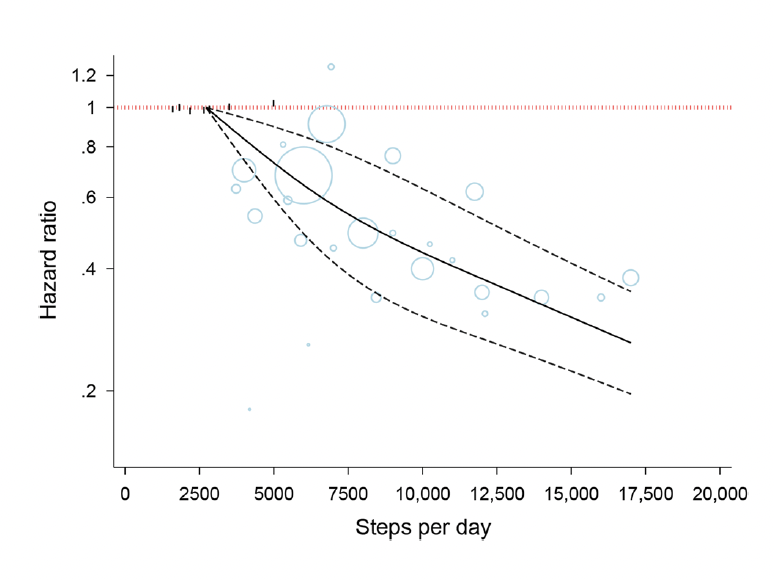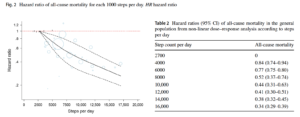How walking is more important than not smoking too make you live longer

I’m a numbers guy.
My favourite book is Fooled by Randomness.
In another life I would have studied mathematics or physics.
My favourite games are games of probabilities.
I believe it stems from being a kid and obsessing over sports statistics. I recall every morning over cereal made completely of sugar (fruit loops and captain crunch were personal favourites) having the sports section of the Toronto Star spread out and studying every statistic imaginable, often missing my bus and driving my parents insane.
Because of this, the lens with which I view the world is typically governed by probabilities, both for the upside and down.
Recently a study came out that likely has the strongest statistical evidence for a single factor to reduce all-cause mortality
(essentially your risk of dying) that has ever been published.
It likely has a stronger association than smoking, or your body composition.
The thing I love the most about it, is that it is an extremely simple variable that nearly everyone can control in their daily lives.
That factor? Walking. Get ready for a completely wild ride into just how important walking is to reduce your likelihood of dying.
This study was a meta-analysis of prospective cohort studies. Simplistically, meta-analyses are where you take similar studies and group their data together to be able to draw stronger conclusions then taking a single study in isolation.
Prospective Cohort studies are considered some of the highest quality research out there. It is when you provide an intervention or observation (like walking), and follow groups over a time period to evaluate a particular variable (like dying).
Combining the 2 in a meta-analysis of prospective cohort studies is as high quality research as you will find.
This particular study looked at something called a hazard ratio. In an overly simplistic definition, this is the chance of an event happening in a study arm versus a control arm. (Keep this in mind for later).
This study grouped 7 prospective studies together for a total of 28,141 participants. There were 2310 cases of all-cause mortality (meaning 2310 people died). The studies were between 5 and 10 years long so had a decent amount of time attributed to them. Typically, they measured step count via a pedometer or accelerometer over 7 consecutive days as this is considered a good proxy for how much somebody walks.
Based upon all of this information they were able to create hazard ratios (your risk of dying) for every 1000 steps walked.
Here is what was found:

That’s a messy graph and chart. Let’s explain.
The chart on the right shows the step count per day and your hazard ratio for all cause mortality. The lower the number the better. They used 2,700 steps as a baseline to compare the risk to. An example at the extreme would be the 16,000 step group. The hazard ratio from walking 16,000 steps compared to 2,700 steps is 0.34. This means you have a 3 fold higher chance of dying by averaging 2,700 steps per day compared to 16,000 steps per day!
That may seem extreme (because it is), however if you look at the chart and accompanying graph, you will notice a very straight, linear relationship between hazard ratio going down as step count goes up. In fact;
“….we found that each 1000 steps per day increment was associated with a 12% lower risk of all cause mortality in the general adult population and a 13% lower risk in adults older than 70 years.”
That is absolutely astounding. Something as trivial as average 5000 steps per day versus 4000 steps lowers you risk of all-cause mortality by 12%.
Right away, my brain went to the fact that correlation does not imply causation. Perhaps it’s just that healthier people tend to walk more. Maybe walking is an overall indicator of somebody’s health and is not a targeted ‘intervention’ and this just reflects people’s general health status.
In reading for this article, Greg Nuchols who is interestingly a massive body builder and far from an endurance athlete pointed out that a 2015 meta-analysis looked at walking as an intervention. They found over just 1 year, participants had a decrease in blood pressure, resting heart rate, body fat %, BMI, cholesterol and depression. Walking also increased VO2max, a 6 minute walk distance test and overall scores of physical functioning. Every one of these things can be associated with all-cause mortality. The positive effects of them all together would be massive.
It was at exactly this point that I realized I’m wrong as usual. Walking likely can indeed be used as a specific intervention to reduce your risk of dying.
In fact Greg must think like I do…..in probabilities. To put further emphasis on the importance of the above statistics, he compared the article to known risks with smoking and Body Mass Index.
Cigarette smoking puts you at a 70-80% higher rate of all cause mortality. I doubt I’m blowing anybody’s mind with that one. BUT, remember earlier in the article were I noted that walking 16,000 steps compared to 2,700 steps had a THREE FOLD increase in all cause mortality.
While you stew on that one, he also pointed out that a BMI above 30 is ‘only’ associated with a 4% increase in all-cause mortality compared to a BMI of 23. And a BMI of 40 is associated with a 74% higher risk.
So statistically, the argument for being sedentary as an independent risk factor for all-cause mortality (walking just 2,700 steps compared to 16,000) MAY BE a larger risk for all-cause mortality then smoking OR obesity.
And what about the 10,000 steps that I feel every single patient I see strives to hit?
One thing I found interesting is that the strongest statistical evidence for a hazard ratio is if it is over 2 or less then 0.5. Look back at that chart. You will see the hazard ratio dips below 0.5 at the 10,000 step mark, making this the ‘cut point’ for the strongest evidence. It also means you have a roughly 2 fold higher risk of dying if you walk only 2,700 steps per day compared to 10,000 steps.
Then I went even further down the rabbit hole and wanted to know how much the typical person walks.
Take a guess. I’ll wait.
In the US, it seems it’s about 5,000-6,500 steps per day. Increasing that number by say 2,000 steps would drop all-cause mortality risk by about 25%!!!!!!
What is the conclusion here? The Kissel family is getting a dog. I’m not kidding. I finally got approval from the wife.
